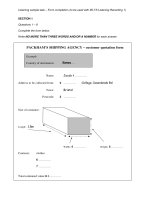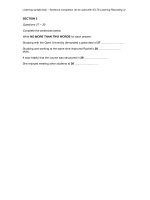AC R Sample Task Type 1 Task
Bạn đang xem bản rút gọn của tài liệu. Xem và tải ngay bản đầy đủ của tài liệu tại đây (89.39 KB, 3 trang )
Sample task type 1
[Note: This is an extract from an Academic Reading passage on the subject of
government subsidies to farmers. The text preceding this extract explained how
subsidies can lead to activities which cause uneconomical and irreversible changes
to the environment.]
All these activities may have damaging environmental impacts. For example, land clearing
for agriculture is the largest single cause of deforestation; chemical fertilisers and pesticides
may contaminate water supplies; more intensive farming and the abandonment of fallow
periods tend to exacerbate soil erosion; and the spread of monoculture and use of high
yielding varieties of crops have been accompanied by the disappearance of old varieties of
food plants which might have provided some insurance against pests or diseases in future.
Soil erosion threatens the productivity of land in both rich and poor countries. The United
States, where the most careful measurements have been done, discovered in 1982 that
about onefifth of its farmland was losing topsoil at a rate likely to diminish the soil's
productivity. The country subsequently embarked upon a program to convert 11 per cent of
its cropped land to meadow or forest. Topsoil in India and China is vanishing much faster
than in America.
Government policies have frequently compounded the environmental damage that farming
can cause. In the rich countries, subsidies for growing crops and price supports for farm
output drive up the price of land. The annual value of these subsidies is immense: about
$250 billion, or more than all World Bank lending in the 1980s. To increase the output of
crops per acre, a farmer's easiest option is to use more of the most readily available inputs:
fertilisers and pesticides. Fertiliser use doubled in Denmark in the period 19601985 and
increased in The Netherlands by 150 per cent. The quantity of pesticides applied has risen
too: by 69 per cent in 19751984 in Denmark, for example, with a rise of 115 per cent in the
frequency of application in the three years from 1981.
In the late 1980s and early 1990s some efforts were made to reduce farm subsidies. The
most dramatic example was that of New Zealand, which scrapped most farm support in
1984. A study of the environmental effects, conducted in 1993, found that the end of
fertiliser subsidies had been followed by a fall in fertiliser use (a fall compounded by the
decline in world commodity prices, which cut farm incomes). The removal of subsidies also
stopped landclearing and overstocking, which in the past had been the principal causes of
erosion. Farms began to diversify. The one kind of subsidy whose removal appeared to
have been bad for the environment was the subsidy to manage soil erosion.
Sample task type 1
In less enlightened countries, and in the European Union, the trend has been to reduce
rather than eliminate subsidies, and to introduce new payments to encourage farmers to
treat their land in environmentally friendlier ways, or to leave it fallow. It may sound strange
but such payments need to be higher than the existing incentives for farmers to grow food
crops. Farmers, however, dislike being paid to do nothing. In several countries they have
become interested in the possibility of using fuel produced from crop residues either as a
replacement for petrol (as ethanol) or as fuel for power stations (as biomass). Such fuels
produce far less carbon dioxide than coal or oil, and absorb carbon dioxide as they grow.
They are therefore less likely to contribute to the greenhouse effect. But they are rarely
competitive with fossil fuels unless subsidised and growing them does no less
environmental harm than other crops.
Sample task type 1
Questions 10 – 12
Choose the appropriate letters A, B, C or D.
Write your answers in boxes 1012 on your answer sheet.
10 Research completed in 1982 found that in the United States soil erosion
A reduced the productivity of farmland by 20 per cent.
B was almost as severe as in India and China.
C was causing significant damage to 20 per cent of farmland.
D could be reduced by converting cultivated land to meadow or forest.
11 By the mid1980s, farmers in Denmark
A used 50 per cent less fertiliser than Dutch farmers.
B used twice as much fertiliser as they had in 1960.
C applied fertiliser much more frequently than in 1960.
D more than doubled the amount of pesticide they used in just 3 years.
12 Which one of the following increased in New Zealand after 1984?
A farm incomes
B use of fertiliser
C overstocking
D farm diversification









